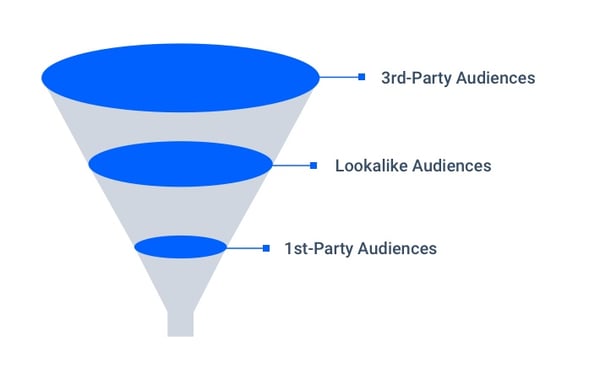Programmatic advertising offers a large opportunity for agencies looking to increase their inventory and audience reach for their digital campaigns.
Outside of walled gardens, like Facebook and LinkedIn, Demand Side Platforms (DSPs) allow advertisers to cast a wider net to capture more prospects.
A DSP allows you to purchase ad placements from a number of ad exchanges, tapping into various inventory sources simultaneously, pulling from a number of data aggregators for targeting and offering sophisticated technology to get the job done.
While relevant inventory and compelling creatives are necessary for your campaign’s success, precise targeting to reach your desired audience is the most important piece of the advertising puzzle. You can have a great, creative campaign, but if your message isn’t reaching the correct demographic, it is less likely to achieve success.
Why use third-party audiences for programmatic campaigns
There are so many options when it comes to audience targeting. It can be overwhelming to choose the best option for your brand and your goals – especially when you’re driving brand awareness and don’t exactly know where to find your ideal customer.
Enter third-party audience segments.
What is a third-party audience?
Third-party audiences are curated data sets comprised of specific segments. Data intelligence companies collect user data anonymously based on demographic or psychographic behavior and curate relevant audience segments.
To use third-party audience segments in your campaigns, you can search the characteristics you are looking to target: gender, age, geographical location, income, hobbies, political party, and more, and as you find segments that fit your desired targeting, the data provider will allow you to access and target users who match.
First-party audiences are those that are proprietary to you and can be generated based on visits to and actions on your own website, for example.
Why not just use first-party data?
These are generally used for retargeting purposes or are suppression lists in prospecting campaigns, as you know these users are familiar with your site and have shown real interest or are existing customers. That said, not only do they work best when used as a bottom-funnel tactic, but they can also restrict your scale if used at the top of the funnel.
Someone who is identified as part of your first-party audience has performed a conversion action such as making a purchase, attending an event, or staying at your hotel.
You know their buying habits, and you have their information to retarget them. If you were to only rely on first-party audiences, you would target the same group of visitors over and over again and limit yourself to relying on these recurring customers or hoping for organic traffic to appear.
|
TIP: Want to ensure a boost in organic traffic? See how G2 hit and surpassed 1 million in organic traffic in only one year for tips on how to do it yourself.

|
This is fine for a short while, but certainly not sustainable if you’re looking to expand your reach.
Why use third-party audiences?
Third-party partners have relationships with data providers that an advertiser does not. They enable you to increase your overall audience scope and gain access to transactional data and other in-depth access points that are highly scalable.
There might be an incremental budget required to access these audiences, but you will definitely be able to reach a more targeted set of users.
To build a pool for retargeting, so users return to your site, you first need to introduce them to your product. This is why third-party audiences are important – they bring users to the top of the funnel and allow you to reach new users that may not have found your website organically.
Your goal is to get enough scale to increase awareness while still ensuring you are capturing individuals who are likely interested to learn more about your offer.
Once you have an idea of the types of users you want to target, you can even leverage lookalike audience targeting to expand your reach to additional users.
These users are not familiar with your site, so they are not first-party, but they are not necessarily in the existing audience segments. That said, they demonstrate similar characteristics to your target audience and, therefore, are worth targeting.
Finally, once your third-party audiences and lookalike audiences have visited your site, you will collect them as first-party audiences for retargeting purposes.
This is the ideal full funnel approach to audience targeting.

How to incorporate third-party audiences in your media mix
With numerous data providers and segments available, it’s a breeze to incorporate third-party audiences in your media mix.
Because third-party audiences are best used for building awareness, you will likely use them in your prospecting campaign to increase your reach to a wider range of prospects.
With the appropriate targeting in place, you can use your creatives to capture the attention of the highly relevant users. Once you have attracted new users through third-party segments, you have the ability to retarget interested prospects.
While buyer personas are a natural starting point, first-party data is the best way to drive the sale home at the bottom of the funnel.
Conclusion
The partnerships that exist between a DSP and data aggregators offer audience segments to increase the ability to target the right buyer at the right stage in your funnel.
The ideal scenario is to have a programmatic partner that provides access to a large variety of audience segments and leverage the right DSP for your digital campaigns will provide a plethora of targeting options, including third-party audiences.
Learn what other users have to say about DSP software to find the right one for you!



 by Christiana Marouchos
by Christiana Marouchos
 by Christiana Marouchos
by Christiana Marouchos
 by Ilija Sekulov
by Ilija Sekulov